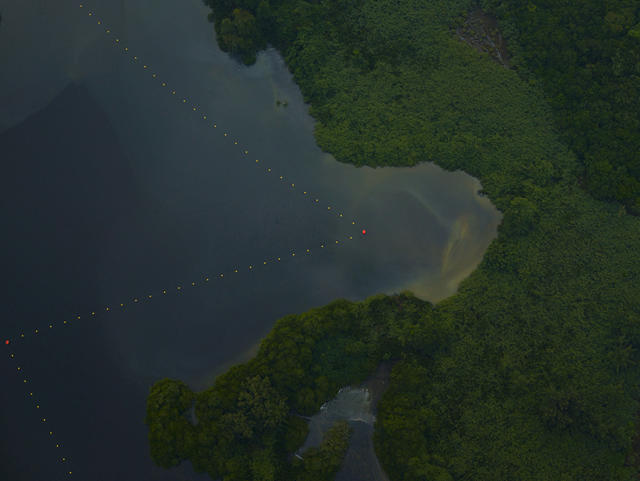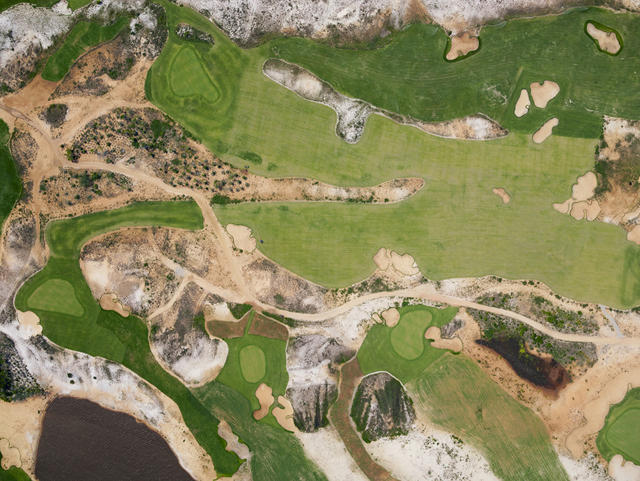

In July 2015, one year before the Olympic Games that will begin in Rio de Janeiro next month, the Associated Press conducted a five-month-long investigation into the “chronically polluted” water where some of the events will take place. What the AP described in an impressively reported 2,500 words, the British photographer Giles Price presents in a single image. His aerial photo of Rio’s Guanabara Bay shows water tinged a noxious yellowish-brown—stark visual evidence that the sewage and trash runoff from construction has been poisoning the water.

The image is one in a series of photographs Price took while leaning out of a helicopter, capturing a wide view of Rio in full construction mode. Price, a former war photographer, has traveled to Rio three times in the past two years in an effort to document its transformation into the host of the 2016 Summer Olympic Games. Capturing the evolution from the sky, he says, offers a different, and often more impactful, perspective. “It just gives that sense of scale and sense of context,” he says. “When you’re on the ground [at the bay], you might see a few dead fish, but when you pull out, you can see the full effect of the pollution and how it dissipates into the bay.”
Price’s series Morar Olimpiadas—also published as a book—offers a unique visual representation of the social repercussions and environmental impact that the Olympic preparations have had on the city. In early images, piles of dirt and bulldozers dot the landscape below, showing the beginnings of a relatively quick construction process. A photo that Price took in 2014, for instance, shows the foundation for an Olympic venue creeping toward the edge of a favela, one of themany Brazilian slums that have been demolished to make way for the games. Toward the end of the book, an image taken in 2016 shows a parking lot standing in the favela’s place, having removed all but around 20 families who refused to move.

Another photo, taken in 2015, shows the beginnings of the Olympic golf course being built while Brazil was suffering from an extended drought. Though the effects of the drought are visible in the course’s dry and crumbling fairways, the grass is a lush green, thanks to irrigation.
Price started to work on Morar Olimpiadas following a similar series of aerial shots that documented the construction of the London Olympics, the majority of which was taking place very close to his home. After learning that photographing the site was prohibited on the ground, Price took to the skies. Much like with his series in Rio, Price wanted to offer an unobstructed, objective perspective on the construction that was transforming his city. By mixing in those images with a series of portraits of construction workers, Price also wanted to give a face to the unsung army of workers that were making it happen.
The big difference between London and Rio, Price says, is how quickly the sites were constructed. “Whatever I may feel about the expense and the inequality and the long-term legacy of the games for these people on the ground [in Rio], what they built, they built pretty quickly,” Price says. “They were literally pushing dirt around when I first started the series, and then in two years built a fair amount of infrastructure.” By contrast, the London builders were all but finished with major construction a year out, Price says, and were putting on the finishing touches like painting and landscaping.
The rapid construction in Rio has come at the expense of people forcibly removed from their homes, as well as the environment. Price named the series and bookMorar Olimpiadas (roughly, Live the Olympics) as a play on the 2010 Morar Carioca plan by the country to reintegrate the favelas into the infrastructure of Rio—a plan which hasn’t exactly panned out. Likewise, the pledge that the government made to clean up the polluted water of the Guanabara Bay before the sailing events are held there also wasn’t upheld. It is now expected to be completed by 2025 at the earliest.
With his images, Price is hoping to shed light on such situations—the harmful results of a second-world city taking on too large of a strain at the expense of its lower-class citizens. “It’s an abstract way of visually grabbing someone to tell a narrative,” he says of his photos. “Now, when millions of images are made every day, how do you get people interested enough to say, ‘What am I looking at here?'”
[Source:- Co.Design]





